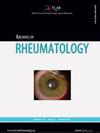Performance of the 2022 American College of Rheumatology/European Alliance of Associations for Rheumatology Classification Criteria for antineutrophil cytoplasmic antibody-associated vasculitis in previously diagnosed adult patients from Türkiye
IF 1.1
4区 医学
Q4 Medicine
引用次数: 0
Abstract
Objectives: This study aimed to evaluate the applicability of the new 2022 American College of Rheumatology (ACR)/European Alliance of Associations for Rheumatology (EULAR) criteria in Turkish adult patients previously diagnosed with antineutrophil cytoplasmic antibody-associated vasculitis (AAV). Patients and methods: One hundred sixty-four patients (96 males, 68 females; mean age: 49.6±14.4 years; range, 18 to 87 years) diagnosed with AAV by experienced rheumatologists between July 2016 and May 2022 were included in this retrospective cross-sectional study and reclassified based on the 1990 ACR criteria, the European Medicines Agency (EMEA) algorithm, and the 2022 ACR/EULAR criteria. For external validation, 83 patients (48 males, 35 females; mean age: 47.3±17.5 years; range, 19 to 81 years) diagnosed with immunoglobulin (Ig)A vasculitis were included. Results: One hundred twenty-six (76.8%) patients had granulomatosis with polyangiitis (GPA), 13 (7.9%) patients had eosinophilic granulomatosis with polyangiitis (EGPA), and 25 (15.2%) patients had microscopic polyangiitis (MPA). According to the criteria, the number of unclassified patients was nine (5.5%) for both the 2022 ACR/EULAR AAV classification criteria and the EMEA algorithm. The new criteria had an almost perfect agreement with the clinician's diagnosis (Cohen’s kappa coefficient [κ]=0.858 for GPA, κ=0.820 for EGPA, and κ=0.847 for MPA). The kappa statistics for agreement of 2022 ACR/EULAR classification criteria with the EMEA algorithm were found 0.794 for GPA, 0.820 for EGPA, and 0.700 for MPA. None of the 83 patients diagnosed with IgA vasculitis could be classified as GPA, EGPA, or MPA using the new ACR/EULAR AAV classification criteria. Conclusion: The 2022 ACR/EULAR classification criteria for AAV showed substantial or perfect agreement with the clinical diagnosis and the EMEA algorithm.2022 年美国风湿病学会/欧洲风湿病学协会联盟抗中性粒细胞胞浆抗体相关性血管炎分类标准在土耳其既往确诊的成年患者中的应用情况
研究目的本研究旨在评估 2022 年美国风湿病学会 (ACR) / 欧洲风湿病学协会联盟 (EULAR) 新标准在既往被诊断为抗中性粒细胞胞浆抗体相关性脉管炎 (AAV) 的土耳其成年患者中的适用性。患者和方法:这项回顾性横断面研究纳入了 164 名在 2016 年 7 月至 2022 年 5 月期间由经验丰富的风湿病专家诊断为 AAV 的患者(96 名男性,68 名女性;平均年龄:49.6±14.4 岁;范围:18 至 87 岁),并根据 1990 年 ACR 标准、欧洲药品管理局 (EMEA) 算法和 2022 年 ACR/EULAR 标准进行了重新分类。为了进行外部验证,研究还纳入了83名确诊为免疫球蛋白(Ig)A血管炎的患者(48名男性,35名女性;平均年龄:47.3±17.5岁;范围:19至81岁)。结果126例(76.8%)患者患有肉芽肿伴多血管炎(GPA),13例(7.9%)患者患有嗜酸性粒细胞肉芽肿伴多血管炎(EGPA),25例(15.2%)患者患有显微镜下多血管炎(MPA)。根据标准,在2022年ACR/EULAR AAV分类标准和EMEA算法中,未分类患者的数量均为9例(5.5%)。新标准与临床医生的诊断几乎完全一致(GPA的科恩卡帕系数[κ]=0.858,EGPA的科恩卡帕系数[κ]=0.820,MPA的科恩卡帕系数[κ]=0.847)。2022年ACR/EULAR分类标准与EMEA算法的一致性卡帕统计结果显示,GPA为0.794,EGPA为0.820,MPA为0.700。根据新的 ACR/EULAR AAV 分类标准,83 名确诊为 IgA 血管炎的患者中没有一人可被归类为 GPA、EGPA 或 MPA。结论:2022 年 ACR/EULAR AAV 分类标准与临床诊断和 EMEA 算法基本一致或完全一致。
本文章由计算机程序翻译,如有差异,请以英文原文为准。
求助全文
约1分钟内获得全文
求助全文
来源期刊

Archives of rheumatology
Medicine-Rheumatology
CiteScore
2.00
自引率
9.10%
发文量
15
期刊介绍:
The Archives of Rheumatology is an official journal of the Turkish League Against Rheumatism (TLAR) and is published quarterly in March, June, September, and December. It publishes original work on all aspects of rheumatology and disorders of the musculoskeletal system. The priority of the Archives of Rheumatology is to publish high-quality original research articles, especially in inflammatory rheumatic disorders. In addition to research articles, brief reports, reviews, editorials, letters to the editor can also be published. It is an independent peer-reviewed international journal printed in English. Manuscripts are refereed by a "double-blind peer-reviewed" process for both referees and authors.
Editorial Board of the Archives of Rheumatology works under the principles of The World Association of Medical Editors (WAME), the International Council of Medical Journal Editors (ICMJE), and Committee on Publication Ethics (COPE).
 求助内容:
求助内容: 应助结果提醒方式:
应助结果提醒方式:


